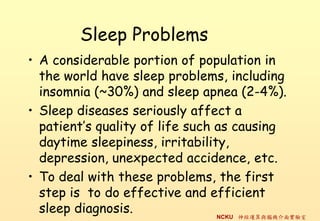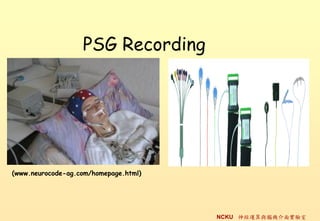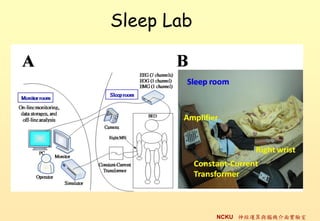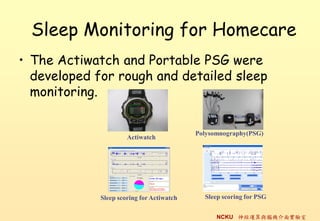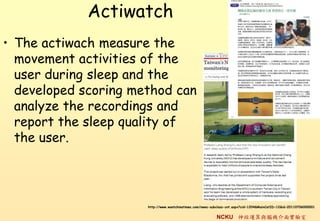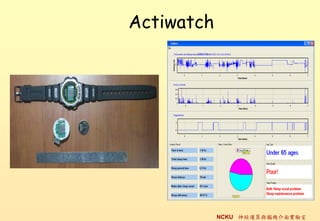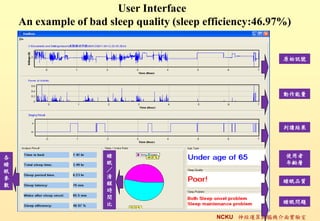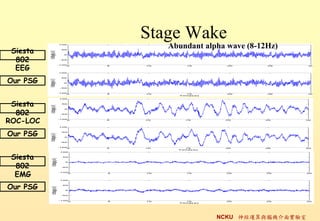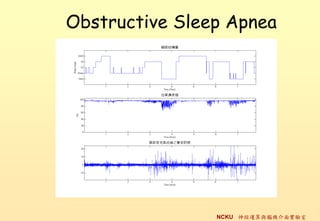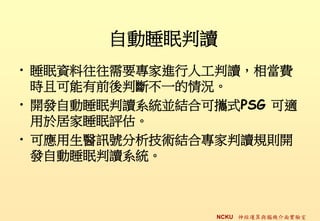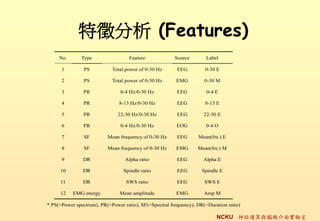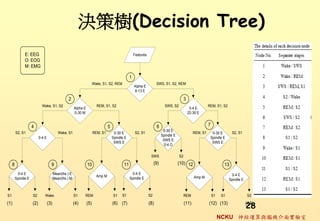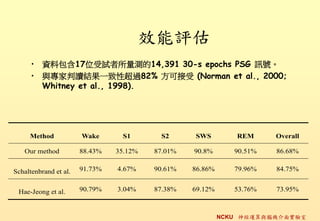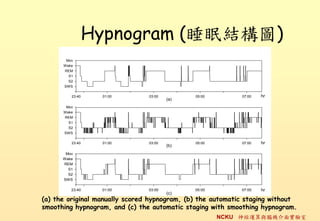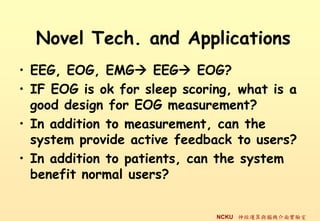ŇJͬ┼c┐Ă╝╝ Ďď╦»├▀×Ú└ř
- 1. ╚¤Í¬ËŰ┐Ă╝╝-Ďď╦»├▀×Ú└ř ┴║ ä┘ Ş╗ │╔╣Ž┤ˇîW ┘YËŹ╣Ą│╠¤Á/┘Y╣Ą╦¨/ßt┘Y╦¨ sfliang@mail.ncku.edu.tw Lab:╔˝ŻŤ▀\╦Ń┼c─XÖCŻÚ├ŠîŹ˛×╩Ď http://ncbci.csie.ncku.edu.tw/ Nov. 27, 2012 NCKU ╔˝ŻŤ▀\╦Ń┼c─XÖCŻÚ├ŠîŹ˛×╩Ď
- 2. Sleep ? Approximately 1/3 of the human lifespan is spent in sleeping. ? An 8 hour sleep comprises 4 or 5 sleep cycles. ? Each cycle lasts approximately 90 minutes and comprises different stages including ? ght sleep (Stages 1 & 2), deep sleep (Slow Wave Sleep), rapid eye movement (REM). Wake S1 REM REM REM REM REM S2 SWS 1 2 3 4 5 6 7 8 NCKU ╔˝ŻŤ▀\╦Ń┼c─XÖCŻÚ├ŠîŹ˛×╩Ď
- 3. Sleep Problems ? A considerable portion of population in the world have sleep problems, including insomnia (~30%) and sleep apnea (2-4%). ? Sleep diseases seriously affect a patientí»s quality of life such as causing daytime sleepiness, irritability, depression, unexpected accidence, etc. ? To deal with these problems, the first step is to do effective and efficient sleep diagnosis. NCKU ╔˝ŻŤ▀\╦Ń┼c─XÖCŻÚ├ŠîŹ˛×╩Ď
- 4. Sleep Diagnosis ? All-night polysomnographic (PSG) recordings ĘC electroencephalograms (EEGs), ĘC electrooculograms (EOGs), ĘC electromyograms (EMGs), are usually acquired from patients in hospitals or sleep centers. ? Problems ĘC First night effect in in an unfamiliar environment. ĘC Disturbance from multiple recording wires of PSG affects sleep quality. ĘC Visual sleep scoring is a time-consuming and subjective process. - NCKU ╔˝ŻŤ▀\╦Ń┼c─XÖCŻÚ├ŠîŹ˛×╩Ď
- 5. PSG Recording (www.neurocode-ag.com/homepage.html) NCKU ╔˝ŻŤ▀\╦Ń┼c─XÖCŻÚ├ŠîŹ˛×╩Ď
- 6. Sleep Lab NCKU ╔˝ŻŤ▀\╦Ń┼c─XÖCŻÚ├ŠîŹ˛×╩Ď
- 7. Sleep Monitoring for Homecare ? The Actiwatch and Portable PSG were developed for rough and detailed sleep monitoring. Polysomnography(PSG) Actiwatch Sleep scoring for Actiwatch Sleep scoring for PSG NCKU ╔˝ŻŤ▀\╦Ń┼c─XÖCŻÚ├ŠîŹ˛×╩Ď
- 8. Actiwatch ? The actiwach measure the movement activities of the user during sleep and the developed scoring method can analyze the recordings and report the sleep quality of the user. http://www.wantchinatimes.com/news-subclass-cnt.aspx?cid=1204&MainCatID=12&id=20110706000001 NCKU ╔˝ŻŤ▀\╦Ń┼c─XÖCŻÚ├ŠîŹ˛×╩Ď
- 9. Actiwatch NCKU ╔˝ŻŤ▀\╦Ń┼c─XÖCŻÚ├ŠîŹ˛×╩Ď
- 10. Consistency Comparison (a) Result of sleep efficiency of Sadehí»s method (b) Result of sleep efficiency of Jean-Louisí»s method (c) Result of sleep efficiency of Sazonovaí»s method (d) Result of sleep efficiency of Tilmanneí»s method (e) Result of sleep efficiency of our method NCKU ╔˝ŻŤ▀\╦Ń┼c─XÖCŻÚ├ŠîŹ˛×╩Ď
- 11. Overnight Scoring Sadeh, 1994 sleep wake 100 200 300 400 500 600 700 800 900 (a) Jean-Jouis, 2001 sleep wake 100 200 300 400 500 600 700 800 900 (b) Sazonova, 2004 sleep wake 100 200 300 400 500 600 700 800 900 (c) Tilmanne, 2009 sleep wake 100 200 300 400 500 600 700 800 900 (d) Our algorithm sleep wake 100 200 300 400 500 600 700 800 900 (e) PSG sleep wake 100 200 300 400 500 600 700 800 900 (f) (I2MTC, 2011) Epoch NCKU ╔˝ŻŤ▀\╦Ń┼c─XÖCŻÚ├ŠîŹ˛×╩Ď
- 12. User Interface An example of bad sleep quality (sleep efficiency:46.97%) ďş╩╝ËŹ╠ľ äËθ─▄┴┐ ┼đÎxŻY╣ű ޸ ╦» ╩╣Ë├Ň▀ ╦» ├▀ ─ŕřgîË ├▀ ú» ůó ăň đĐ ╦»├▀ĂĚ┘| öÁ Ľr Úg ▒╚ ╦»├▀ćľţ} NCKU ╔˝ŻŤ▀\╦Ń┼c─XÖCŻÚ├ŠîŹ˛×╩Ď
- 13. Portable PSG for Homecare ? A modularized and distributed PSG system that is more convenient and has potential for recording at home. ? It is composed of multiple tiny, low-cost and wireless-synchronized signal acquisition nodes, and each node acquires specific physiological signals including, EEG, EOG EMG, airflow, respiratory bands, and blood oxygen saturation. NCKU ╔˝ŻŤ▀\╦Ń┼c─XÖCŻÚ├ŠîŹ˛×╩Ď
- 14. Portable PSG for Homecare NCKU ╔˝ŻŤ▀\╦Ń┼c─XÖCŻÚ├ŠîŹ˛×╩Ď
- 15. Novelty ? Each modualized node acquires specific physiological signals within a small body region. ? Novel wireless-synchronization technology is utilized to reduce sleep disturbance. ? The developed system has better comfortableness performance in terms of several objective and subjective sleep indices. NCKU ╔˝ŻŤ▀\╦Ń┼c─XÖCŻÚ├ŠîŹ˛×╩Ď
- 16. Agreement Evaluation NCKU ╔˝ŻŤ▀\╦Ń┼c─XÖCŻÚ├ŠîŹ˛×╩Ď
- 17. PSG Signals spindle K-complex delta waves Fast eye movements absent EMG NCKU ╔˝ŻŤ▀\╦Ń┼c─XÖCŻÚ├ŠîŹ˛×╩Ď
- 18. R&K Sleep Staging Rechtschaffen and Kales (1968) Sleep Staging Criteria Sleep Stage Scoring Criteria >50% of the page (epoch) consists of alpha (8-13 Hz) activity or low voltage, Waking mix (2-7 Hz) frequency activity. 50% of the page (epoch) consists of related low voltage mixed (2-7 Hz) Stage 1 activity. Slow rolling eye movements lasting several seconds often seen in early stage 1. Appearance of sleep spindles and/or K complexes and <20% of the epoch may Stage 2 contain high voltage (>75 Ž╠V, <2 Hz) activity. Sleep spindles and K complexes each must last >0.5 seconds. 20%-50% of the epoch consists of high voltage (>75 Ž╠V), low frequency <2 Stage 3 Hz activity. Stage 4 >50% of the epoch consists of high voltage (>75 Ž╠V), <2 Hz delta activity. Relatively low voltage mixed (2-7 Hz) frequency EEG with episodic rapid eye Stage REM movements and absent or reduced chin EMG activity. NCKU ╔˝ŻŤ▀\╦Ń┼c─XÖCŻÚ├ŠîŹ˛×╩Ď
- 19. Stage Wake Abundant alpha wave (8-12Hz) Siesta 802 EEG Our PSG Siesta 802 ROC-LOC Our PSG Siesta 802 EMG Our PSG NCKU ╔˝ŻŤ▀\╦Ń┼c─XÖCŻÚ├ŠîŹ˛×╩Ď
- 20. Stage 2 Spindles 1s K-complex 2s Siesta 802 EEG Our PSG Siesta 802 ROC-LOC Our PSG Siesta 802 EMG Our PSG 20 NCKU ╔˝ŻŤ▀\╦Ń┼c─XÖCŻÚ├ŠîŹ˛×╩Ď
- 21. SWS 9s 2s Siesta 802 EEG Our PSG Siesta 802 ROC-LOC Our PSG Siesta 802 EMG Our PSG 21 NCKU ╔˝ŻŤ▀\╦Ń┼c─XÖCŻÚ├ŠîŹ˛×╩Ď
- 22. REM Siesta 802 EEG Our PSG Siesta 802 ROC-LOC Rapid eye movements Our PSG Siesta 802 EMG The chin EMG activity was absent or reduced Our PSG NCKU ╔˝ŻŤ▀\╦Ń┼c─XÖCŻÚ├ŠîŹ˛×╩Ď
- 23. Comfort Comparison 1 AROUSAL NUMBER IN THE TWO-PHASE EXPERIMENT PHASE1 PHASE2 THE THE THE THE Subjects REFERENCE PROPOSED REFERENCE PROPOSED SYSTEM SYSTEM SYSTEM SYSTEM 1 15 13 19 26 2 13 12 17 12 3 18 15 16 15 4 19 12 24 9 5 9 9 11 7 6 16 13 29 18 Average 15 12.3 19.3 14.5 SD. 3.32 1.8 5.79 6.29 2 NCKU ╔˝ŻŤ▀\╦Ń┼c─XÖCŻÚ├ŠîŹ˛×╩Ď
- 24. Obstructive Sleep Apnea NCKU ╔˝ŻŤ▀\╦Ń┼c─XÖCŻÚ├ŠîŹ˛×╩Ď
- 25. ÎďäË╦»├▀┼đÎx ? ╦»├▀┘Y┴¤═¨═¨đŔϬîú╝Ď▀Mđđ╚╦╣Ą┼đÎxúȤӫö┘M ĽrăĎ┐╔─▄Ëđă░ßß┼đöÓ▓╗Ď╗Á─ăÚŤríú ? Ú_░lÎďäË╦»├▀┼đÎx¤ÁŻyüKŻY║¤┐╔öy╩ŻPSG ┐╔▀m Ë├ýÂżË╝Ď╦»├▀ďu╣└íú ? ┐╔ŬË├╔˙ßtËŹ╠ľĚÍ╬÷╝╝đgŻY║¤îú╝Ď┼đÎxĎÄätÚ_ ░lÎďäË╦»├▀┼đÎx¤ÁŻyíú NCKU ╔˝ŻŤ▀\╦Ń┼c─XÖCŻÚ├ŠîŹ˛×╩Ď
- 26. ĚĘď˛╩ŻÎď»╦»├▀┼đÂ┴¤Á═│ Preprocessing Feature Extraction Classification Movement epochs Input: EEG (C3-A2), Downsampling detection EOG, EMG (256Hz) Spectral / temporal feature extraction Staging with a rule (12 Features) based decision Band-pass filtering tree (14 rules) (EEG/EOG 0.5-30Hz, EMG 5-100Hz) Contextual rule Feature smoothing Segmented into Normalization 30-s epochs Movement epochs Scoring elimination Result 26 ?í░A Rule-based Automatic Sleep Staging Method,í▒ Journal of Neuroscience Methods, vol. 205, no. 1, pp. 169-176, 2012. NCKU ╔˝ŻŤ▀\╦Ń┼c─XÖCŻÚ├ŠîŹ˛×╩Ď
- 27. ╠ěßšĚÍ╬÷ (Features) No. Type Feature Source Label 1 PS Total power of 0-30 Hz EEG 0-30 E 2 PS Total power of 0-30 Hz EMG 0-30 M 3 PR 0-4 Hz/0-30 Hz EEG 0-4 E 4 PR 8-13 Hz/0-30 Hz EEG 8-13 E 5 PR 22-30 Hz/0-30 Hz EEG 22-30 E 6 PR 0-4 Hz/0-30 Hz EOG 0-4 O 7 SF Mean frequency of 0-30 Hz EEG Mean(fre.) E 8 SF Mean frequency of 0-30 Hz EMG Mean(fre.) M 9 DR Alpha ratio EEG Alpha E 10 DR Spindle ratio EEG Spindle E 11 DR SWS ratio EEG SWS E 12 EMG energy Mean amplitude EMG Amp M * PS(=Power spectrum), PR(=Power ratio), SF(=Spectral frequency), DR(=Duration ratio) NCKU ╔˝ŻŤ▀\╦Ń┼c─XÖCŻÚ├ŠîŹ˛×╩Ď
- 28. ŤQ▓▀śń(Decision Tree) E: EEG Features O: EOG M: EMG 1 Wake, S1, S2, REM SWS, S1, S2, REM Alpha E 8-13 E 2 3 Wake, S1, S2 REM, S1, S2 SWS, S2 REM, S1, S2 Alpha E 0-4 E 0-30 M 22-30 E 4 5 6 7 0-30 E S2, S1 Wake, S1 REM, S1 0-30 E S2, S1 REM, S1 0-30 E S2, S1 Spindle E 0-4 E Spindle E Spindle E SWS E SWS E SWS E 0-4 O SWS S2 8 9 10 11 (9) (10) 12 13 0-4 E Mean(fre.) E 0-4 E 0-4 E Amp M Amp M Spindle E Mean(fre.) M Spindle E Spindle E S1 S2 Wake S1 REM S1 S1 S2 REM S1 S1 S2 (1) (2) (3) (4) (5) (6) (7) (8) (11) (12) (13) 28 (14) NCKU ╔˝ŻŤ▀\╦Ń┼c─XÖCŻÚ├ŠîŹ˛×╩Ď
- 29. đž─▄Ă└╣└ ? ┘Y┴¤░Ř║Č17╬╗╩▄ďçŇ▀╦¨┴┐ťyÁ─14,391 30-s epochs PSG ËŹ╠ľíú ? ┼cîú╝Ď┼đÎxŻY╣űĎ╗Í┬đď│Č▀^82% ĚŻ┐╔ŻË╩▄ (Norman et al., 2000; Whitney et al., 1998). Method Wake S1 S2 SWS REM Overall Our method 88.43% 35.12% 87.01% 90.8% 90.51% 86.68% Schaltenbrand et al. 91.73% 4.67% 90.61% 86.86% 79.96% 84.75% Hae-Jeong et al. 90.79% 3.04% 87.38% 69.12% 53.76% 73.95% NCKU ╔˝ŻŤ▀\╦Ń┼c─XÖCŻÚ├ŠîŹ˛×╩Ď
- 30. Hypnogram (╦»├▀ŻYśőłD) Mov Wake REM S1 S2 SWS 23:40 01:00 03:00 05:00 07:00 hr (a) Mov Wake REM S1 S2 SWS 23:40 01:00 03:00 05:00 07:00 hr (b) Mov Wake REM S1 S2 SWS 23:40 01:00 03:00 05:00 07:00 hr (c) (a) the original manually scored hypnogram, (b) the automatic staging without smoothing hypnogram, and (c) the automatic staging with smoothing hypnogram. NCKU ╔˝ŻŤ▀\╦Ń┼c─XÖCŻÚ├ŠîŹ˛×╩Ď
- 31. Sleep Scoring System NCKU ╔˝ŻŤ▀\╦Ń┼c─XÖCŻÚ├ŠîŹ˛×╩Ď
- 32. Novel Tech. and Applications ? EEG, EOG, EMG? EEG? EOG? ? IF EOG is ok for sleep scoring, what is a good design for EOG measurement? ? In addition to measurement, can the system provide active feedback to users? ? In addition to patients, can the system benefit normal users? NCKU ╔˝ŻŤ▀\╦Ń┼c─XÖCŻÚ├ŠîŹ˛×╩Ď



